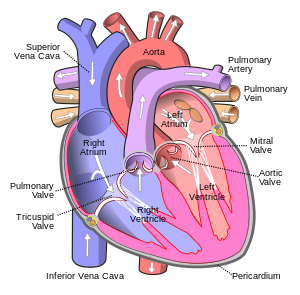Pulmonary insufficiency
| Pulmonary valve insufficiency | |
|---|---|
| Other names | Pulmonary regurgitation, pulmonary incompetence |
 | |
| Diagram of the human heart | |
| Specialty | Cardiology |
| Causes | Pulmonary hypertension, Infective endocarditis[1] |
| Diagnostic method | EKG, Echocardiogram[2] |
| Treatment | Depends on cause[3](See cause) |
Pulmonary (or pulmonic[4]) insufficiency (or incompetence, or regurgitation) is a condition in which the pulmonary valve is incompetent[5] and allows backflow from the pulmonary artery to the right ventricle of the heart during diastole.[6] While a small amount of backflow may occur ordinarily, it is usually only shown on an echocardiogram and is harmless. More pronounced regurgitation that is noticed through a routine physical examination is a medical sign of disease and warrants further investigation.[medical citation needed] If it is secondary to pulmonary hypertension it is referred to as a Graham Steell murmur.[7]
Signs and symptoms[]
Because pulmonic regurgitation is the result of other factors in the body, any noticeable symptoms are ultimately caused by an underlying medical condition rather than the regurgitation itself.[3] However, more severe regurgitation may contribute to right ventricular enlargement by dilation, and in later stages, right heart failure.[8] A diastolic decrescendo murmur can sometimes be identified,( heard best) over the left lower sternal border.[medical citation needed]
Causes[]

Among the causes of pulmonary insufficiency are:
- Pulmonary hypertension[1]
- Infective endocarditis[1]
- Rheumatic heart disease[1]
- Connective tissue disease[8]
- Carcinoid syndrome[8]
- Congenital abnormalities[9]
- Tetralogy of Fallot,[10]
- Prosthetic heart valve[11]
Pathophysiology[]
The pathophysiology is due to diastolic pressure variations between the pulmonary artery and right ventricle, differences are often very small, but increase regurgitation. An elevation in pulmonary insufficiency due to elevated intrathoracic pressure is relevant in ventilated patients (having acute restrictive right ventricular physiology). The reasons for changes in stiffness of the right ventricle's walls are not well understood, but such stiffness is thought to increase with hypertrophy of the ventricle.[12]
Diagnosis[]
In the diagnosis of pulmonary insufficiency both echocardiograms and ECG is used to ascertain if the individual has this condition, as well as, the use of a chest x-ray to expose enlargement of the right atrium or ventricle.[2]
Treatment[]
In treating pulmonary insufficiency, it should be determined if pulmonary hypertension is causing the problem to therefore begin the most appropriate therapy as soon as possible (primary pulmonary hypertension or secondary pulmonary hypertension due to thromboembolism).[13] Furthermore, pulmonary insufficiency is generally treated by addressing the underlying condition,[3] in certain cases, the pulmonary valve may be surgically replaced.[14]
See also[]
References[]
- ^ Jump up to: a b c d Booker, editors, Carol L. Lake, Peter D. (2005). Pediatric cardiac anesthesia (4th ed.). Philadelphia: Lippincott Williams & Wilkins. p. 430. ISBN 978-0-7817-5175-9. Retrieved 30 August 2015.CS1 maint: extra text: authors list (link)
- ^ Jump up to: a b "Pulmonary Valve Disease. About Pulmonary valve disease | Patient". Patient. Retrieved 2015-08-29.
- ^ Jump up to: a b c McGlothlin, edited by Michael H. Crawford, Komandoor Srivathson, Dana P. (2006). Current consult. New York, NY: Lange Medical Books/McGraw-Hill. p. 269. ISBN 978-0-07144-010-3.CS1 maint: extra text: authors list (link)
- ^ T. R. Harrison (ed.): Principles of Internal Medicine, Third Edition, McGraw-Hill, New York / Toronto / London 1958, p. 1258.
- ^ "Pulmonary Insufficiency". FreeDictionary. Farlex. 2014. Retrieved 29 August 2015.
- ^ White, Charles S.; Haramati, Linda B.; Chen, Joseph Jen-Sho; Levsky, Jeffrey M. (2014-03-01). Cardiac Imaging. OUP USA. p. 402. ISBN 9780199829477.
- ^ Auscultation Skills: Breath & Heart Sounds. Lippincott Williams & Wilkins. 2009-10-01. p. 83. ISBN 9781605474540.
- ^ Jump up to: a b c "Pulmonic Regurgitation Clinical Presentation". Medscale.com. eMedicine. Retrieved 29 August 2015.
- ^ "pulmonary Valve disease". Patient.info. EMIS Group. Retrieved 29 August 2015.
- ^ Alpert, Joseph (2012). Cardiology and the Primary care Physician (3rd ed.). Current Medicine. p. 306. ISBN 978-1-4615-6603-8. Retrieved 29 August 2015.
- ^ O'Connor, Nicholas J. Talley, Simon (2014). Clinical examination : a systematic guide to physical diagnosis (Seventh ed.). Sydney [etc.]: Elsevier, Churchill Livingstone. p. 108. ISBN 978-0-72954-147-3. Retrieved 29 August 2015.
- ^ Chaturvedi, Rajiv R; Redington, Andrew N (2007-07-01). "Pulmonary regurgitation in congenital heart disease". Heart. 93 (7): 880–889. doi:10.1136/hrt.2005.075234. ISSN 1355-6037. PMC 1994453. PMID 17569817.
- ^ "Pulmonic Regurgitation Treatment & Management: Medical Care, Surgical Care, Consultations". 2018-06-28. Cite journal requires
|journal=(help) - ^ "Heart valve surgery: MedlinePlus Medical Encyclopedia". www.nlm.nih.gov. Retrieved 2015-08-30.
Further reading[]
- Lake, Carol L.; Booker, Peter D. (2005-01-01). Pediatric Cardiac Anesthesia. Lippincott Williams & Wilkins. ISBN 9780781751759.
- Bruce, Charles J.; Connolly, Heidi M. (2009-05-26). "Right-Sided Valve Disease Deserves a Little More Respect". Circulation. 119 (20): 2726–2734. doi:10.1161/CIRCULATIONAHA.108.776021. ISSN 0009-7322. PMID 19470901.
- M.D, Steven Lehrer (2011-12-27). Understanding Pediatric Heart Sounds. Steven Lehrer. ISBN 9781468138030.
External links[]
- "Problem: Pulmonary Valve Regurgitation". www.heart.org. Retrieved 2015-08-29.
| Classification | |
|---|---|
| External resources |
| Scholia has a topic profile for Pulmonary insufficiency. |
- Valvular heart disease
- Vascular diseases
- Medical signs